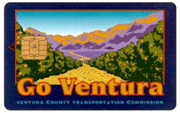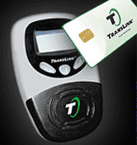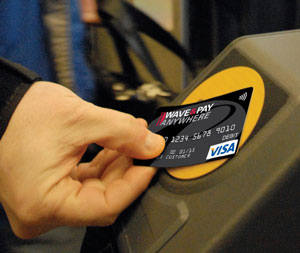Transit and Retail Payment: Opportunities for Collaboration and Convergence
29 March, 2005
category: Contactless, Financial, Library, Transit
 Reprinted with the permission of the Smart Card Alliance
Reprinted with the permission of the Smart Card Alliance
The face of public transportation in the United States is changing dramatically – for the better. As a result of significant federal and local investment, transit is “updating its look” in an effort to retain existing customers and attract new riders. To achieve this goal, transit systems across the country are expanding, acquiring new rolling stock, and upgrading to state-of-the-art, smart card-based fare collection systems.
Currently, programs to upgrade and modernize the fare collection infrastructure are under way in numerous urban areas, such as Boston, New York/New Jersey, Baltimore, Washington, D.C., Atlanta, Chicago, Minneapolis/Saint Paul, Los Angeles, San Diego, Seattle, Houston, and San Francisco. This infrastructure modernization, which represents what can be characterized as a “once in a generation” investment phenomenon, is part of the natural infrastructure replacement cycle. Fare collection systems first installed in the late 1970s and early 1980s have been reaching the end of their useful life for the last several years. As such, hundreds of millions of dollars have been invested in new fare collection infrastructure in the last several years.
First impressions are a key factor in the development and expansion of transit ridership, and fare collection systems are the first contact point for customers as they enter a transit system. Customers initially purchase or reload fare media and pass through a gate or other portal to catch a train or board a bus. Contactless smart card technology is the foundation for automatic fare collection (AFC) systems that meet customer requirements for quick entry and exit, ease of use, and convenience. Contactless smart card technology is also the ideal platform to link multiple operating modes or multi-operator regional systems together under a seamless, cohesive regional program.
Smart Cards and U.S. Transit Agencies
Mass transit agencies worldwide have been using stored value prepaid cards for electronic ticketing since the 1970s. Through the late 1990s, this market steadily began transitioning from magnetic stripe technology to contactless smart cards. Today, virtually all transit fare payment systems in the delivery and procurement stages use contactless smart cards as the primary ticket medium. Major deployments are already operational in cities around the world, including Hong Kong, Seoul, Pusan, Washington D.C., and Shanghai. The table summarizes current and planned U.S. transit agency smart card programs.
Benefits of Smart Cards for Transit Payment
Smart cards offer numerous benefits for transit fare payment transactions.
Increased customer convenience. A contactless smart card is easy to use. The traveler simply taps the card on the gate reader, with no specific card orientation required. Convenience helps generate ridership growth, enhances the cost-recovery ratio, and improves the transit agency’s bottom line. Contactless smart cards support flexible fare arrangements for riders – for example, automatic discounts and multiple types of fares. When a contactless smart card can be used to pay for any mode of transportation (e.g., subway, bus, train), transfer between operators, perform fare addition and deduction on the fly, and take the guesswork out of paying fares, public transportation is more convenient to consumers and more competitive with the automobile for commuting and discretionary trips.
Efficient and convenient cash replacement. A smart card-based stored value payment system provides an easy-to-use alternative to cash. Consumers can conveniently load and replenish value for transit payment. The smart card also provides an opportunity for transit agencies to partner with the financial industry or with retailers to allow payment for non-transit purchases (e.g., at quick service restaurants or other locations that value fast and convenient consumer payment).
Lower operating costs. While the deployment of a contactless smart card-based system is capital intensive, such a system can lower operating costs. Contactless smart card readers are more reliable and require less maintenance than electromechanical readers. Contactless transit payment cards are more secure, have a longer life, and require fewer replacements than magnetic stripe cards during their life cycle. Contactless smart cards can also increase security and reduce fraud, reduce handling costs for fare media and/or cash, and provide cash flow advantages by shifting riders to prepaid fares.
More efficient revenue management activities. Depending on how the transit operator processes currency, reconciling reports from electronic transactions can be more efficient than processing cash.
Improved customer relationship management. Smart card-based fare collection systems provide transit operators with information about their customers’ activities. Operators can use this data to understand customer behavior and serve customers more effectively. This value is maximized as transit payment systems are deployed across multiple operators in a region. For example, traveler origin and destination information can be used to better coordinate schedules between operators within a region.
Increased product differentiation. Smart cards can help transit operators differentiate their service offerings and offer innovative features to customers. Smart card-based AFC systems can encourage innovative strategic thinking, such as enabling regional transit payment systems or linking transit operators with non-transit partners, resulting in deployment of multi-application payment cards. For example:
 • The Washington Metropolitan Area Transit Authority (WMATA) launched a contactless smart card program called SmarTrip ® in May 1999, with the broad objective of making transit travel easy, simple, and attractive for the customer. Just over five years later, approximately 650,000 SmarTrip cards are in circulation and are currently used to pay fares throughout the MetroRail and MetroBus systems and fees for Metro-operated parking lots. In a move to eliminate cash from the system in mid-2004, SmarTrip is now the only form of payment accepted in Metro-operated parking lots. Program improvements completed in mid-2004 include fleetwide installation of SmarTrip-accepting fareboxes in buses, and smart card vending devices have been deployed in one-third of the rail stations to allow riders to more easily purchase SmarTrip cards. Contracts are in place throughout Washington, D.C., Northern Virginia, and the state of Maryland to populate 15 additional operators with SmarTrip-accepting infrastructure.
• The Washington Metropolitan Area Transit Authority (WMATA) launched a contactless smart card program called SmarTrip ® in May 1999, with the broad objective of making transit travel easy, simple, and attractive for the customer. Just over five years later, approximately 650,000 SmarTrip cards are in circulation and are currently used to pay fares throughout the MetroRail and MetroBus systems and fees for Metro-operated parking lots. In a move to eliminate cash from the system in mid-2004, SmarTrip is now the only form of payment accepted in Metro-operated parking lots. Program improvements completed in mid-2004 include fleetwide installation of SmarTrip-accepting fareboxes in buses, and smart card vending devices have been deployed in one-third of the rail stations to allow riders to more easily purchase SmarTrip cards. Contracts are in place throughout Washington, D.C., Northern Virginia, and the state of Maryland to populate 15 additional operators with SmarTrip-accepting infrastructure.
Since the introduction of the SmarTrip card, several pilot projects have been initiated to test multi-application cards that include transit fare payment. WMATA and Citibank are involved in a pilot program to offer a co-branded card that can be used both as a contactless transit payment card in the WMATA system and as a magnetic stripe payment card for credit card transactions. WMATA reports that the pilot will involve approximately 10,000 participants, with first cards available to the public in November 2004. WMATA has also entered into pilot projects with the U.S. General Services Administration and U.S. Department of Education for a co-branded combination transit-building access card. These projects were initiated in 2000 and 2002, respectively. They include approximately 2,000 cardholders between the two agencies and continue to operate today.
 • In 1999, the Metropolitan Transportation Commission (MTC) of the San Francisco Bay Area awarded a contract for a regional fare collection system that provides a single smart card to be used on every transit system in the area. Approximately 7,000 contactless smart cards, called TransLink® cards, were distributed for Phase 1 of the project. Ultimately, up to 26 transit operators could participate in the program. The card is a dual-interface card, containing both contact and contactless interfaces (complying with ISO/IEC 7816 and ISO/IEC 14443 Type B) for communicating with the card’s microprocessor. For the transit system, the contactless interface is essential, providing ease of use and fast boarding times. The contact interface allows the card to be used for other applications, such as at ATMs or POS terminals, where a contact slot already exists or is more acceptable.
• In 1999, the Metropolitan Transportation Commission (MTC) of the San Francisco Bay Area awarded a contract for a regional fare collection system that provides a single smart card to be used on every transit system in the area. Approximately 7,000 contactless smart cards, called TransLink® cards, were distributed for Phase 1 of the project. Ultimately, up to 26 transit operators could participate in the program. The card is a dual-interface card, containing both contact and contactless interfaces (complying with ISO/IEC 7816 and ISO/IEC 14443 Type B) for communicating with the card’s microprocessor. For the transit system, the contactless interface is essential, providing ease of use and fast boarding times. The contact interface allows the card to be used for other applications, such as at ATMs or POS terminals, where a contact slot already exists or is more acceptable.
It was always envisioned that the smart farecard would be expanded to carry applications beyond the initial transit application. The first instance of this expansion is parking, with the smart card reader being integrated into new electronic parking meters to be installed in San Francisco in 2003 and 2004. The TransLink card can then be used to pay at parking meters throughout the city. Other applications being investigated are tolling (MTC also administers the tolls for the six major bridges in the region), taxis and retail payment.
- In 2000, the Ventura County Transportation Commission awarded a contract to supply an AFC system using smart cards. The system is now in operation and combines the smart card fare medium with automated passenger counting and Global Positioning System (GPS) location. The cards in use are dual-interface smart cards that comply with the ISO/IEC 7816 and ISO/IEC 14443 Type B standards.
The campus of California State University Channel Islands (CSUCI) has its own version of the smart card. The card is used for transit on the VCTC system and serves as a student identity badge for use on campus. The student smart cards carry two epurses–one for transit and one for use on campus. The campus epurse will be suitable for small transactions typical at a university, such as those at vending machines, photocopiers, cafeterias, and for computer services. Other potential uses of the card include on-campus parking and building access.
Efficient implementation of transit benefits programs. Beginning on January 1, 2002, employers were able to offer their employees up to $100 per month in pretax commuting benefits. Program participants can use the benefits to commute to work on buses, commuter and light-rail trains, subways, and vanpools. Transit benefit programs can contribute a large fraction of transit operator revenue. A recently published report by the U.S. General Services Administration, Office of Governmentwide Policy, reported that the 58 agencies responding had spent approximately $210 million on mass transit subsidies (passes, vouchers, or other cash reimbursements) for over 247,000 federal employees during the fiscal year 2002.
Administration of transit benefits programs with magnetic stripe fare media or paper vouchers is difficult. Smart card technology is being considered by organizations implementing transit benefits programs since smart cards can simplify program administration and deliver benefits electronically.
Summary
Smart cards offer significant benefits for transit operators – both for improving customer service and operational efficiency and for opening up opportunities to collaborate with other industry sectors. The public transportation industry is at a crossroads as it considers strategies for the next advances in smart card-based fare payment. Strategically, this is the time for transit operators to explore the potential for linkages to formerly disparate markets and develop partnerships with employers, financial service providers, retailers, and other transportation service providers. By leveraging the new contactless smart card infrastructure, transit operators and their partners can differentiate product and service offerings and create a strategic competitive advantage.
This article is an extract from the Smart Card Alliance report, “Transit and Retail Payment: Opportunities for Collaboration and Convergence,” researched and written by the Smart Card Alliance Terminal and eTransaction Infrastructure Task Force. Individuals from 13 member organizations were involved in the development of the report. Lead contributors included representatives from Bank of America, Cubic Transportation Systems, Datacard Group, EDS, ERG Group, First Data Corporation, IBM, Infineon Technologies, MasterCard International, Smart Commerce, Inc., U.S. Department of Transportation/Volpe Center, ViVOtech, and the Washington Metropolitan Area Transit Authority. The full report and additional information about smart cards and the role that they play in payment and other applications can be found on the Smart Card Alliance web site at www.smartcardalliance.org.
SmarTrip and the Metro logo are registered trademarks of WMATA, TransLink is a registered trademark of the Metropolitan Transportation Commission.
To purchase a copy of the complete 42-page report from the Smart Card Alliance, click here.



